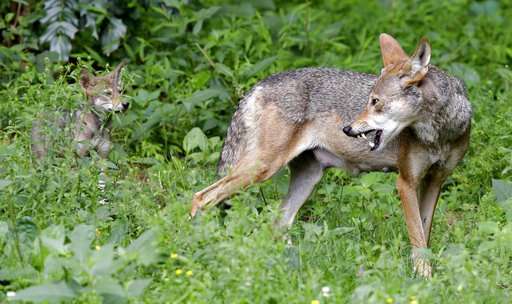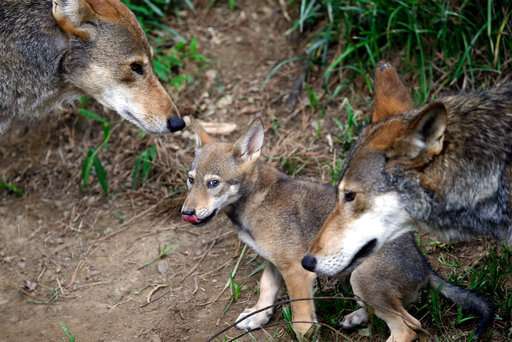US proposes shrinking last endangered red wolf habitat

The Trump administration announced a proposal Wednesday to shrink the habitat of the only endangered red wolves left in the wild, and to give landowners more leeway to kill any of the animals that stray onto private property.
Conservation groups call the proposal an extinction sentence that would doom the very last wild wolves.
"Wolves don't read maps," said Ben Prater, southeast program director of the non-profit Defenders of Wildlife.
An estimated 35 wild red wolves remain—all in eastern North Carolina—down from about 120 of the animals a decade ago. Another 200 currently live in captive breeding programs.
The U.S. Fish and Wildlife Service proposal would limit their territory to federal land in two North Carolina counties and lift restrictions on killing any wolves that stray from that area. It would take several months for the proposal to go into effect.
"The proposal incorporates the best available science and biology of the red wolf," Leopoldo Miranda, an assistant regional director for the agency, told reporters Wednesday.
A recent government report found the declining wild population was unsustainable and already in danger of vanishing in less than a decade. Once common across the Southeast, the red wolf had been considered extinct in the wild as of 1980. Releases of captive-bred wolves started in 1987.
Currently, property owners across the five counties that are home to the wolves need special permission to kill or trap the animals.
Under the new plan, there will be no such prohibition on killing wolves that wander off the proposed habitat of approximately 200,000 acres, according to Miranda.
"They will be able to take the animals without consultation or authorization from the Fish and Wildlife Service," he said, referring to landowners.
Prater said in an interview that the reduced habitat area would support only about 15 wolves, and any that stray would face peril.

The government plan "would essentially result in a death sentence for any wolf that goes off of federal public land," he added.
Federal officials estimate it will take until November to finalize the rule after a public comment period. Until then, red wolves are governed by existing rules and other restrictions ordered by a federal judge.
In 2016, U.S. District Judge Terrence Boyle issued a preliminary injunction that essentially halted all authorizations for landowners to trap or kill the wolves. That ruling exists within the framework of the current red wolf rules, so it doesn't necessarily apply to the new proposal announced Wednesday.
Government lawyers argue in a recent court filing that "such an injunction will become meaningless when the Red Wolf Rule it references is superseded."
However, one of the lawyers leading the lawsuit said Wednesday that Boyle's ruling will stay in place until the government formally asks to lift it.
"The government would have to demonstrate that its plan complies with the Endangered Species Act, and we don't think it does," said Ramona McGee of the Southern Environmental Law Center.
Conservationists argue the wild wolf population's current decline is due to neglect by federal officials who halted releases of captive-born wolves and other efforts to bolster them, such as sterilizing coyotes that compete for territory.
Their lawsuit argues that the Fish and Wildlife Service shifted away from successful management strategies in the past five years because of pressure from a small but vocal group of landowners.
Some landowners argue the wolves are nuisance animals that frequently wander onto their property. They also question whether they are a species unto themselves or a hybrid.
The wildlife service recently issued a report saying it will continue to recognize the species even as Congress has called for further study into its genetics.
© 2018 The Associated Press. All rights reserved.

















